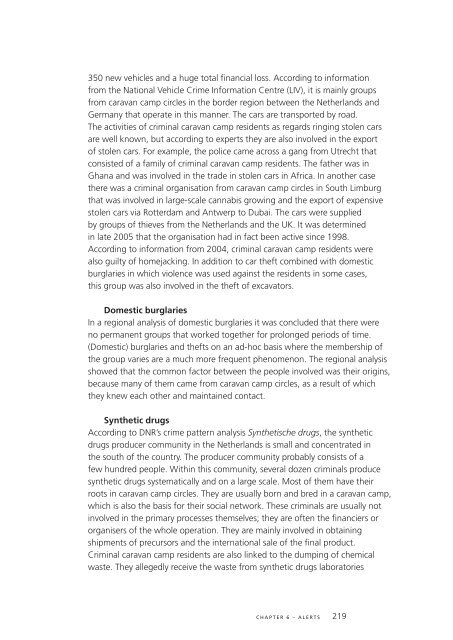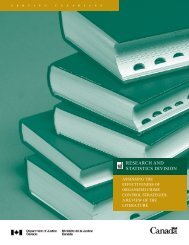National Threat Assessment 2008. Organised Crime - Politie
National Threat Assessment 2008. Organised Crime - Politie
National Threat Assessment 2008. Organised Crime - Politie
Create successful ePaper yourself
Turn your PDF publications into a flip-book with our unique Google optimized e-Paper software.
350 new vehicles and a huge total financial loss. According to information<br />
from the <strong>National</strong> Vehicle <strong>Crime</strong> Information Centre (LIV), it is mainly groups<br />
from caravan camp circles in the border region between the Netherlands and<br />
Germany that operate in this manner. The cars are transported by road.<br />
The activities of criminal caravan camp residents as regards ringing stolen cars<br />
are well known, but according to experts they are also involved in the export<br />
of stolen cars. For example, the police came across a gang from Utrecht that<br />
consisted of a family of criminal caravan camp residents. The father was in<br />
Ghana and was involved in the trade in stolen cars in Africa. In another case<br />
there was a criminal organisation from caravan camp circles in South Limburg<br />
that was involved in large-scale cannabis growing and the export of expensive<br />
stolen cars via Rotterdam and Antwerp to Dubai. The cars were supplied<br />
by groups of thieves from the Netherlands and the UK. It was determined<br />
in late 2005 that the organisation had in fact been active since 1998.<br />
According to information from 2004, criminal caravan camp residents were<br />
also guilty of homejacking. In addition to car theft combined with domestic<br />
burglaries in which violence was used against the residents in some cases,<br />
this group was also involved in the theft of excavators.<br />
Domestic burglaries<br />
In a regional analysis of domestic burglaries it was concluded that there were<br />
no permanent groups that worked together for prolonged periods of time.<br />
(Domestic) burglaries and thefts on an ad-hoc basis where the membership of<br />
the group varies are a much more frequent phenomenon. The regional analysis<br />
showed that the common factor between the people involved was their origins,<br />
because many of them came from caravan camp circles, as a result of which<br />
they knew each other and maintained contact.<br />
Synthetic drugs<br />
According to DNR’s crime pattern analysis Synthetische drugs, the synthetic<br />
drugs producer community in the Netherlands is small and concentrated in<br />
the south of the country. The producer community probably consists of a<br />
few hundred people. Within this community, several dozen criminals produce<br />
synthetic drugs systematically and on a large scale. Most of them have their<br />
roots in caravan camp circles. They are usually born and bred in a caravan camp,<br />
which is also the basis for their social network. These criminals are usually not<br />
involved in the primary processes themselves; they are often the financiers or<br />
organisers of the whole operation. They are mainly involved in obtaining<br />
shipments of precursors and the international sale of the final product.<br />
Criminal caravan camp residents are also linked to the dumping of chemical<br />
waste. They allegedly receive the waste from synthetic drugs laboratories<br />
chapter 6 – alerts<br />
219








